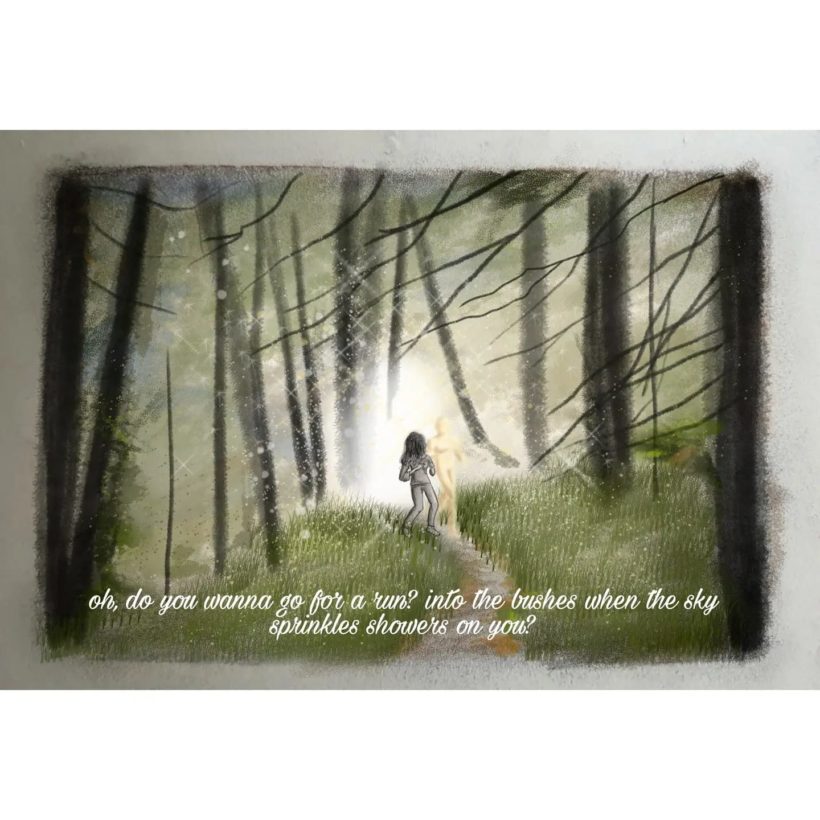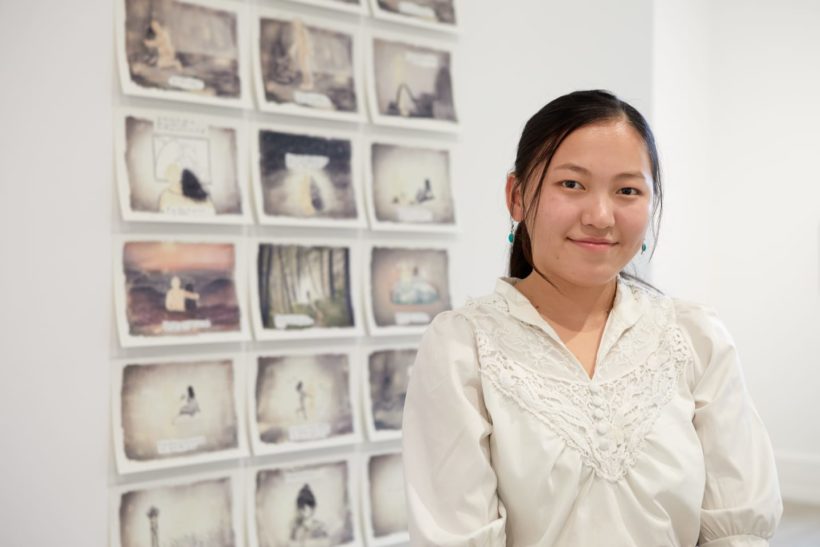Today I’ll tell you a pleasant chat with Sonam Yangdon – Broke Bhutanese Artist- a young 19 year old girl who grew up in a village in Bumthang, central Bhutan, and who has been living in Australia with her family for a few years. It was precisely with her arrival in Australia with the first difficulties of settling in, feeling ‘different’ and moods like loneliness that Sonam began an artistic exploration that led her to discover her talent. Recently her work “Dear Myself” was awarded in the RAW program – a new annual call open to young people aged 16 to 21, which features the best original works of art produced by young people in the Murray region of Australia.
Can you explain the meaning of the name Broke Bhutanese Artist?
I chose this name because I find it funny and can attract followers, it underlines my origins and it is a way to show how artists are in a sense broken – which also means “broke”, for expensive artistic materials. In my initial drawings I always tried to highlight traditional Bhutanese signs, such as houses and landscapes, but also traditional clothing. I was trying to reach out to the Bhutanese audience first and get more attention from them. Now my works are much more open, with a bigger and more universal imagination.
How did you get to Australia and how did your dimension change from a small Himalayan kingdom to a large country?
I came to Australia with my father, mother and brother after my father got a scholarship for a PhD in environmental science. I think coming here has made me mature a lot, it has opened me mentally with new perspectives of myself. In Bhutan there are not many people of other nationalities to meet and the school also hit me and marked me differently, opening my mind. I feel like I’ve become a new person.
What role did art play in this passage?
When I was in Bhutan I had never dedicated myself to art, I thought like many that I was not talented. When I came here and started going to school as a teenager I felt so different, there aren’t many Asians in the area where I live. During high school I felt very isolated and needed something to express myself, the emotions I felt and to be friends with. These difficulties have been a blessing because this is how I discovered the art. This transition really affected me – when I was feeling lonely I used to go to the library during breaks from class and read tons of children’s books, I was impressed with how they made me feel safe and happy and so I started thinking about writing and drawing stories, which can also bring relief to other people. Now that my work is on display at the museum I have received messages asking me for copies of the book that I have not yet published, and this has been very exciting.
The work Dear Myself – Dear myself highlights a beautiful artistic sense but also the exploration of a strong sensitive and emotional dimension, in a dance between dark and light. What does this work tell us about you but also about your generation, especially in the last two years of the pandemic?
When I was feeling very lonely I had decided to work in a restaurant in the evening. One night on my way home I felt so lost because I had no one to talk, so I started imagining someone who was there for me. From there the diary: ‘dear myself how are you …’ and other beautiful words that I wanted someone to say to me. Later, when I reread my diary I thought about putting it in the drawings and so the story was born. I don’t think it was influenced by the years of the pandemic because I am an introverted person, even here I don’t have many friends, I don’t go out much and it’s normal for me to stay so much time at home, a pleasant time to devote to my passions.
I think my personality has changed a lot in recent years – in Bhutan it is always in our head to feel “I am Bhutanese”, “I am proud to be Bhutanese”, “our king is great”. These types of thoughts are truly cultivated in our head. After I arrived here I felt a great change, not that it changed according to the country where I arrived, but a great inner and mental opening, today I can say that I do not belong to Bhutan but to the world.
The Bhutanese have a very strong sense of cultural identity, they are very proud of their uniqueness and I think that is why they are very shy about opening up to people of other nationalities.
You like to produce artisan paper, but also to recover different materials, to recycle clothes and fabrics that are not creative can still be beautiful in new forms. What is the message behind it?
I have liked the fashion designer since I was little, I remember trying to create and recreate fabrics like a game with my mother. I have always thought of becoming a fashion designer, but after I arrived here I discovered ‘fast fashion’, the negative impact it has on people and above all how it affects the environment. I loved buying clothes so much but then with these reflections I felt that it was not right to continue like this and that I could create something unique with the things I already had, I created a new fashion perspective for me. If I hadn’t known the effects of ‘fast fashion’, perhaps I would have continued to desire and buy new clothes as before – this has really changed my point of view. Today I shop in second-hand stores and in a conscious way. I have become very minimalist, I don’t pay much attention to material things.
In recent years, Bhutan is going through a very delicate phase, there are many – especially young people – who are trying to go elsewhere, to move to larger and more modern societies, such as Australia. If I may ask you what is missing here that pushes you elsewhere and what do you miss in your country?
I think the thing that mainly pushes people to other countries is the shortage of jobs. Even if you are out of college and are really prepared and smart it is difficult to get a job. And even if you get a job the pay is very low – I think it’s very depressing for young people to see there is no future in Bhutan. If you come to Australia simply to clean up, for example, you earn more than an officer in Bhutan.
I think that if I returned to Bhutan now I would feel really sad, because here I can continue my artistic career while there is no future for art and fashion designers there. If there was work, many would remain there. Beyond that, I miss everything about Bhutan, every single thing.
Can you keep some traditions alive there?
When we arrived here we brought Bhutanese masks, Buddhist paintings and statues with us to create a comfortable environment. The Bhutanese traditions are almost all religious and concern the connections between families. I believe that the greatest value we have brought here is our family and our bond. I see that here many young at 18 are already out of their families and live alone, but I am still here with my parents and we help each other. This I think is the very heart of Bhutanese culture: the strong bond with the family.
What are your future projects?
Now I am studying podiatry, I think it is a wise decision for me because I will be able to work easily as a therapist and when I have enough resources to support myself I will study art. I think I’ll stay here in Australia, publish my stories and sell my books around the world to reach as many people as possible. When things go well I will devote myself full time to art and put aside the activity as a therapist. I think I will go to Bhutan every year for the holidays and to spend a month there, all my family, my grandparents and my friends are there.
For those wishing to find out more about Sonam and its art, on Instagram you will find many designs, stories and clothes reinvented with a careful approach to sustainability. Here are the links with her profiles
https://instagram.com/brokebhutaneseartist?igshid=YmMyMTA2M2Y=
https://instagram.com/brk_designing?igshid=YmMyMTA2M2Y=

A drawing by Dear Myself, 2021 digitally printed drawings, courtesy of the artist.










